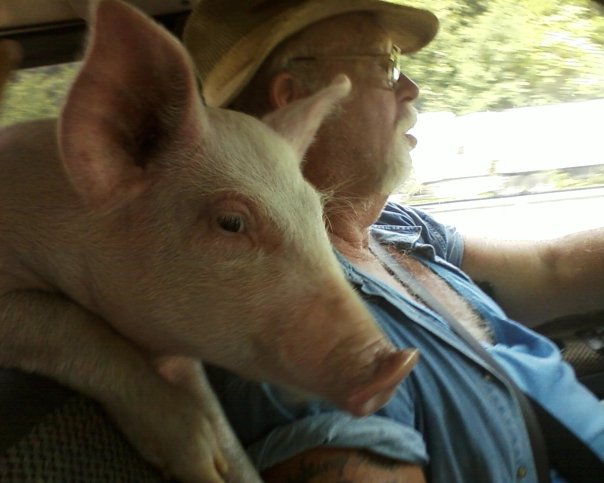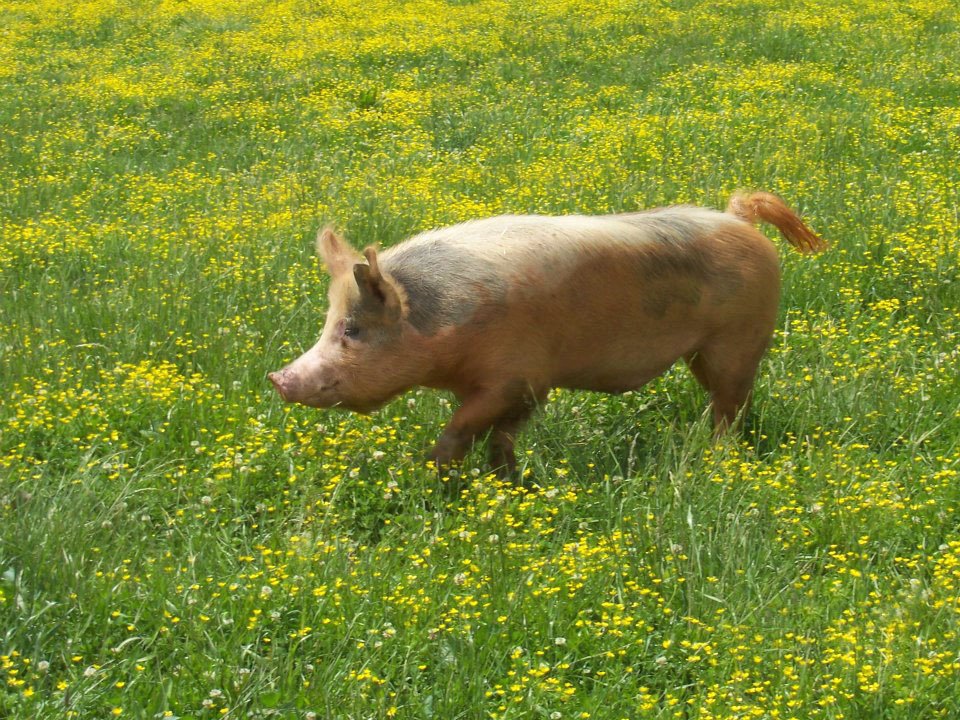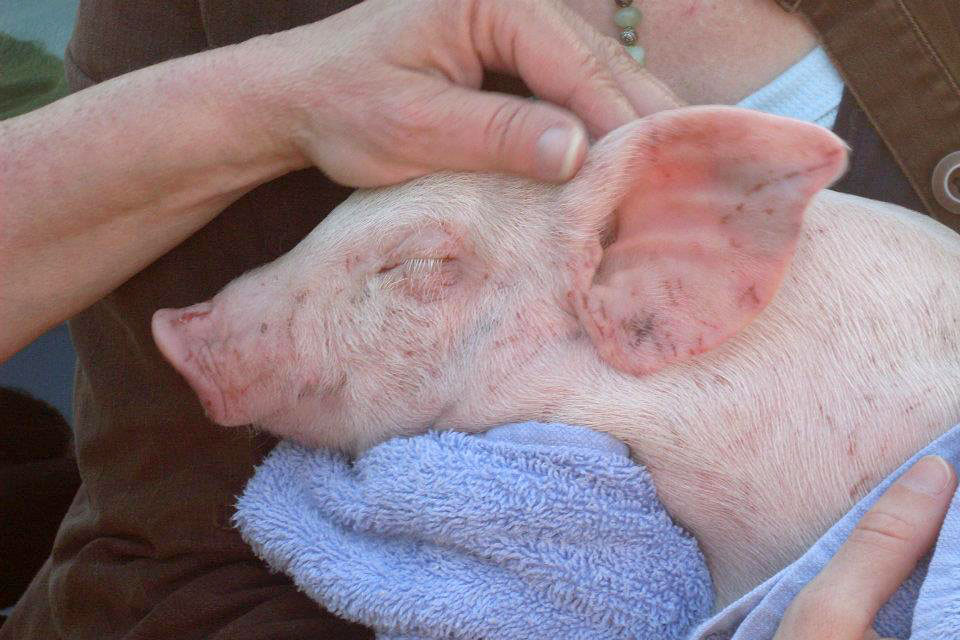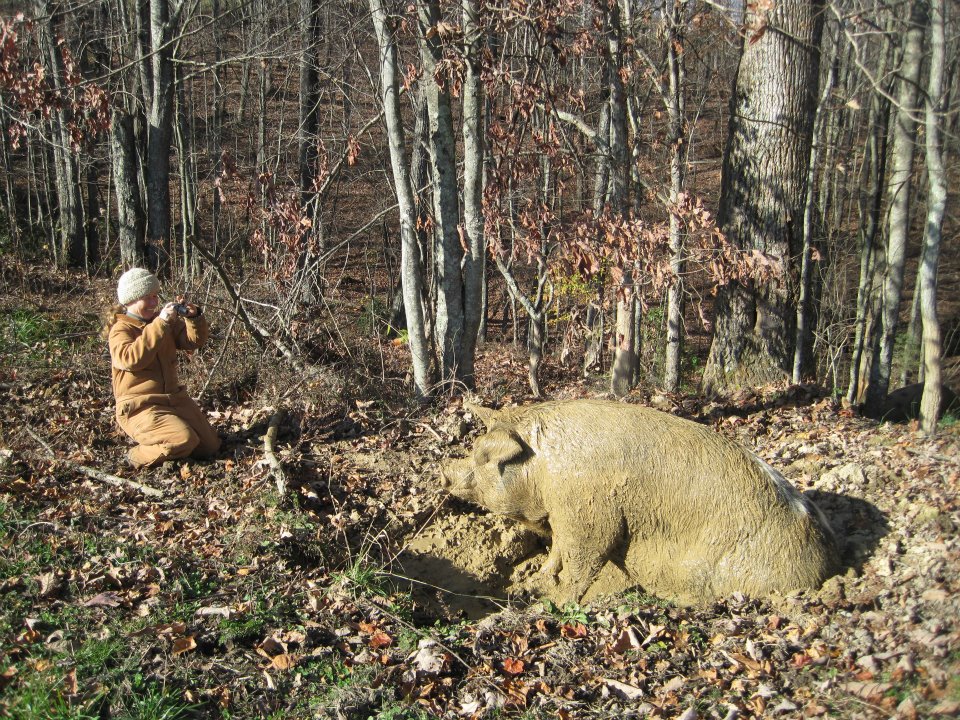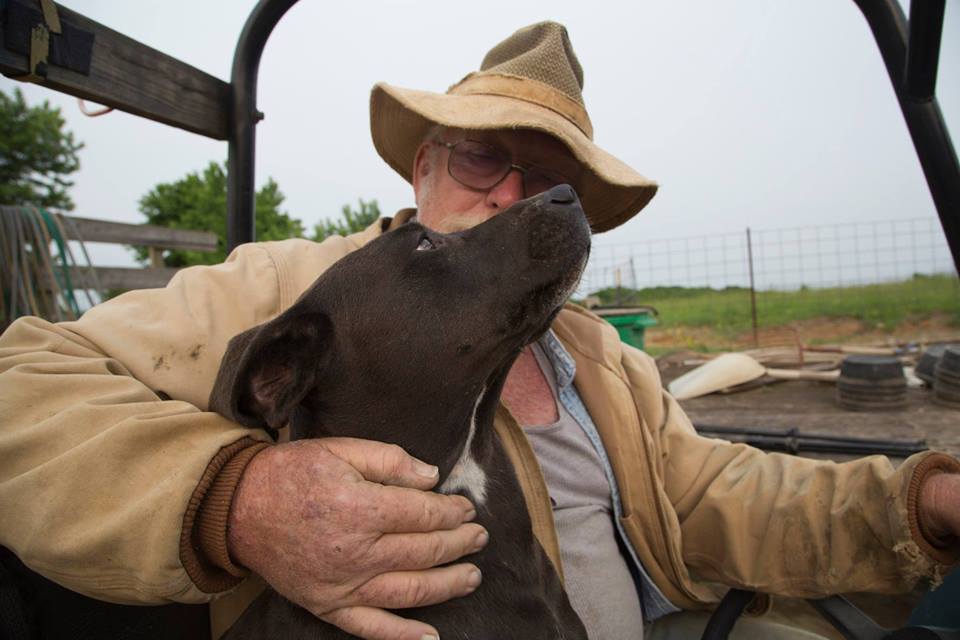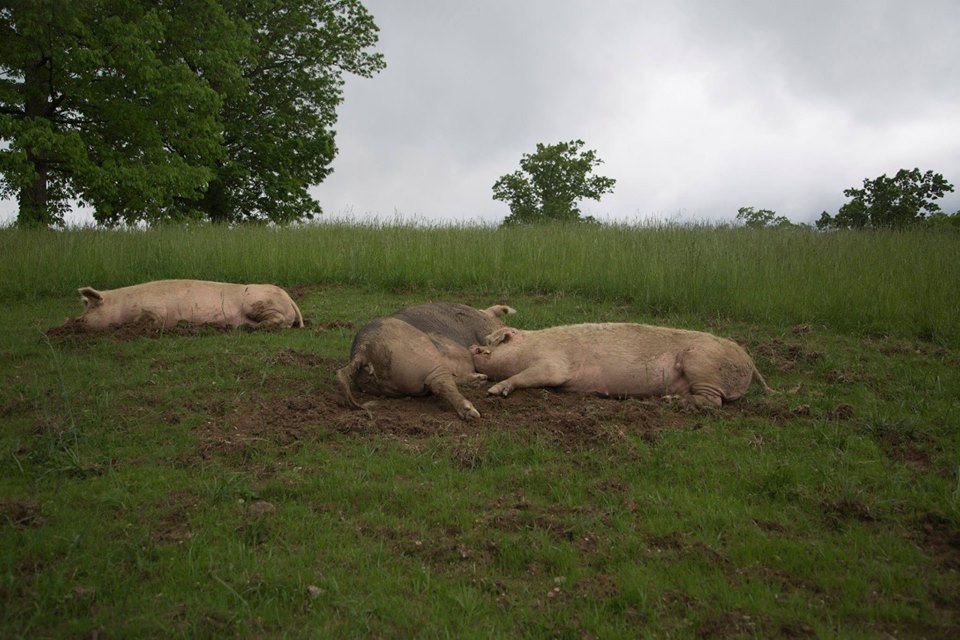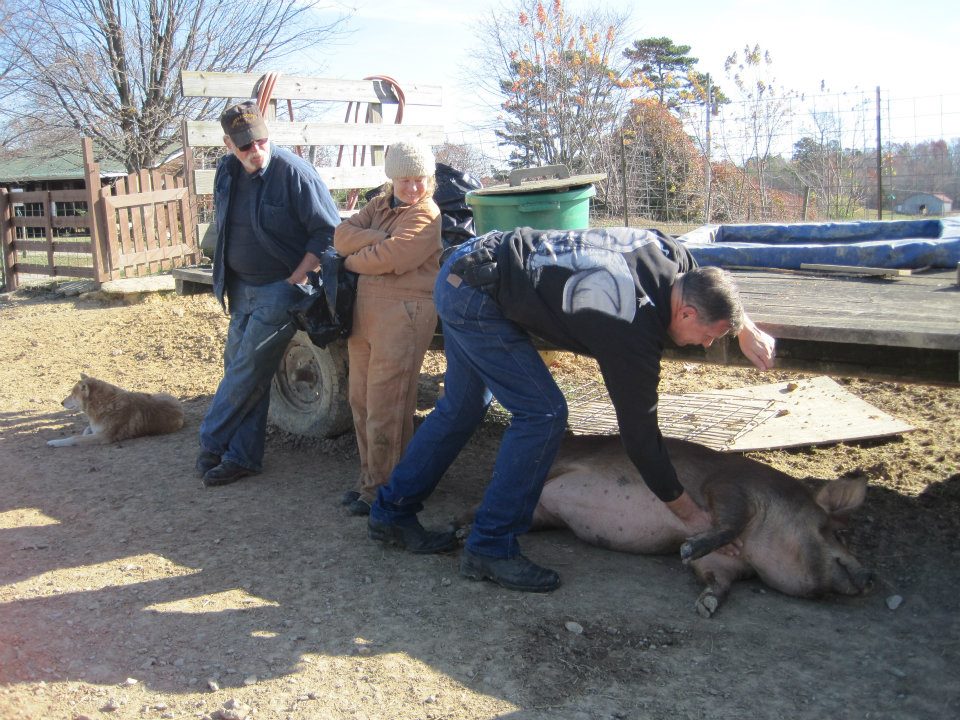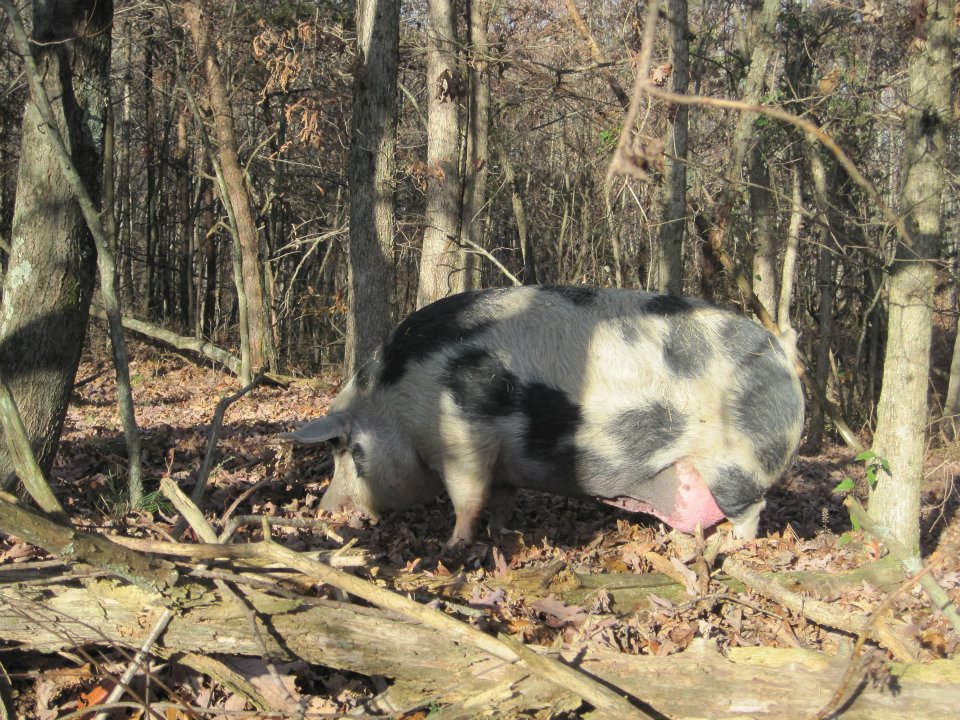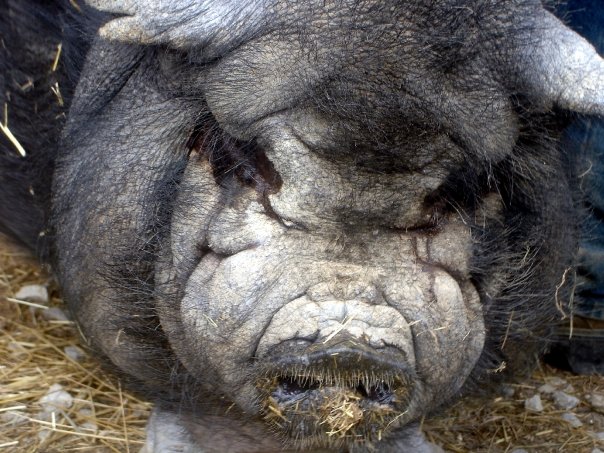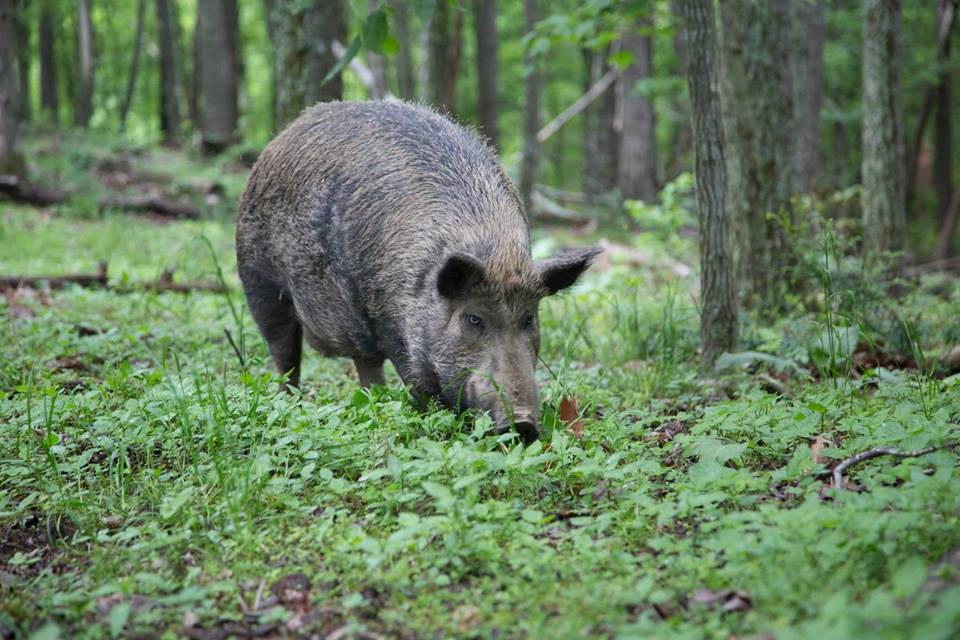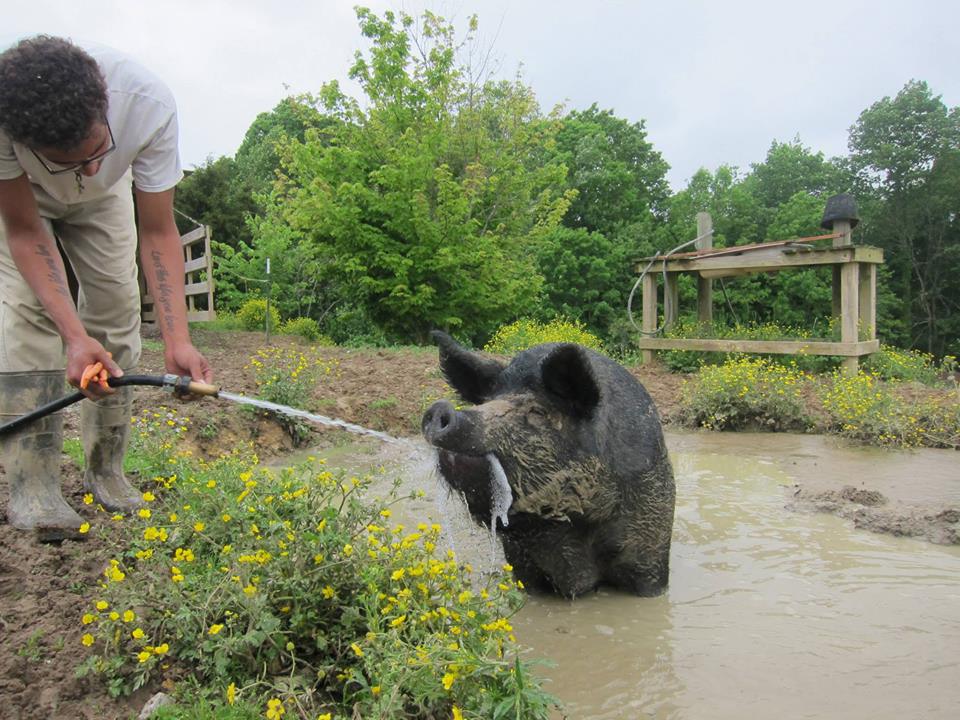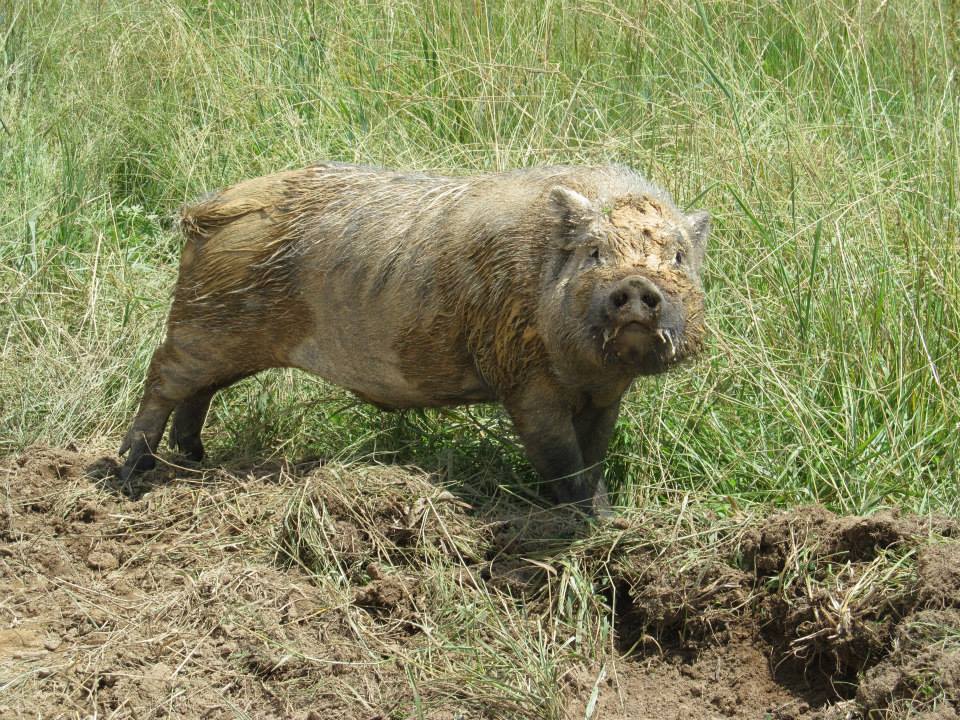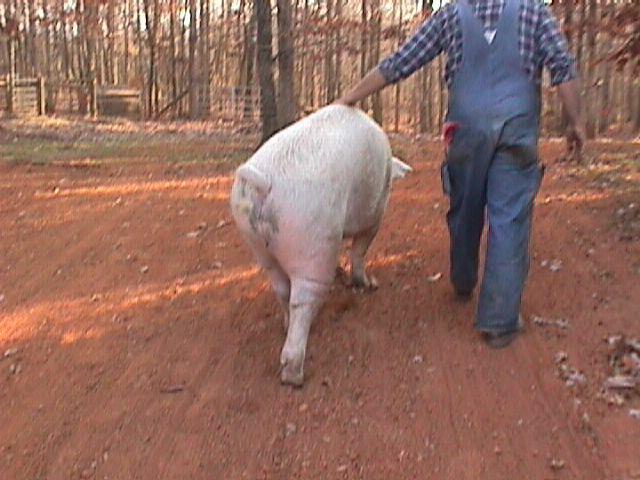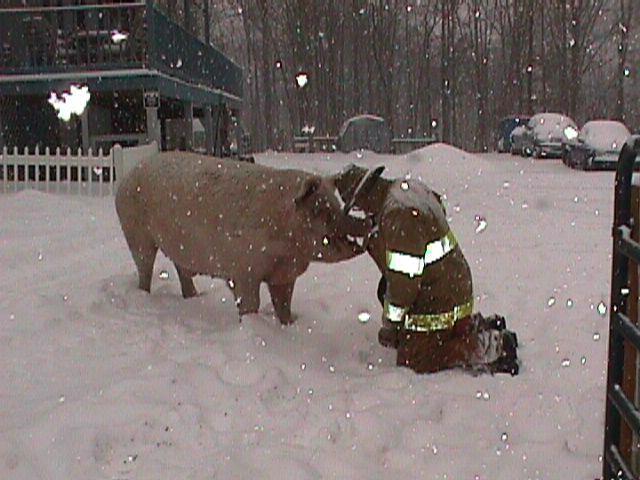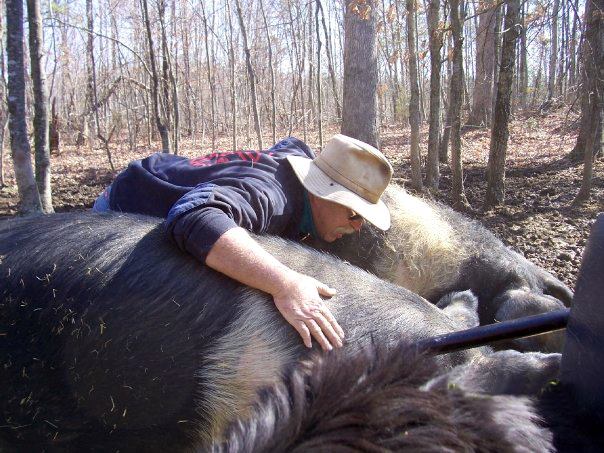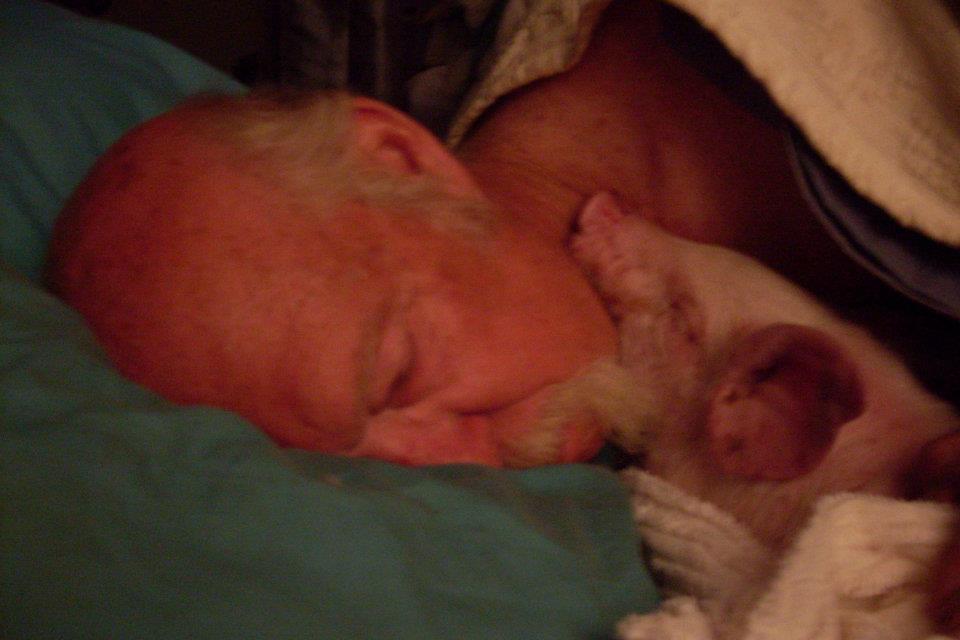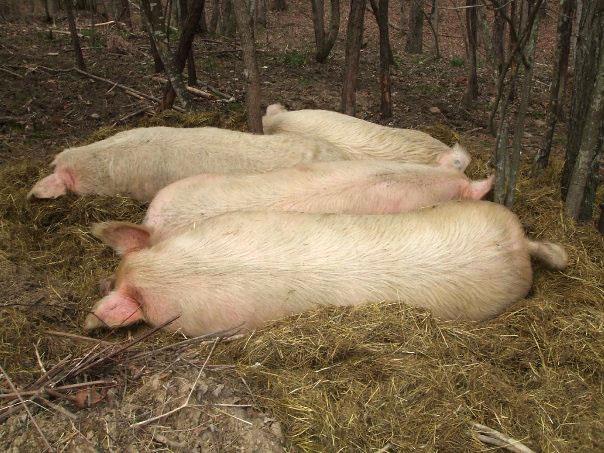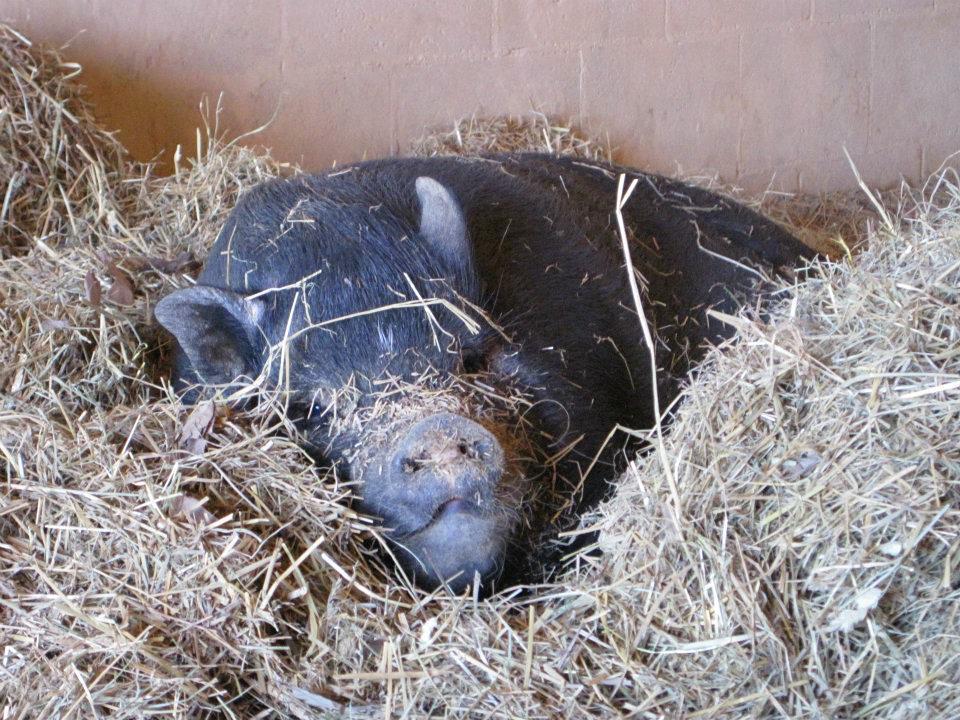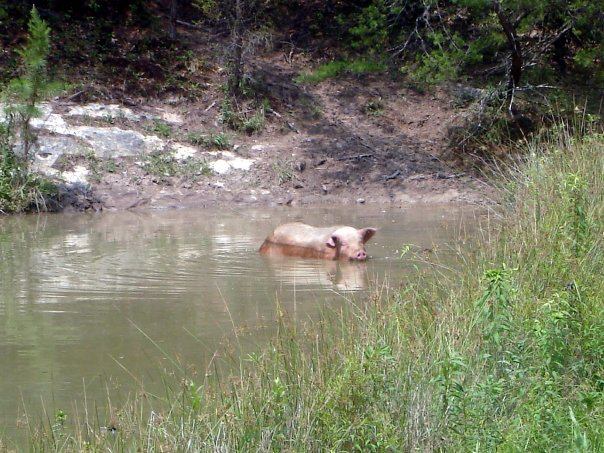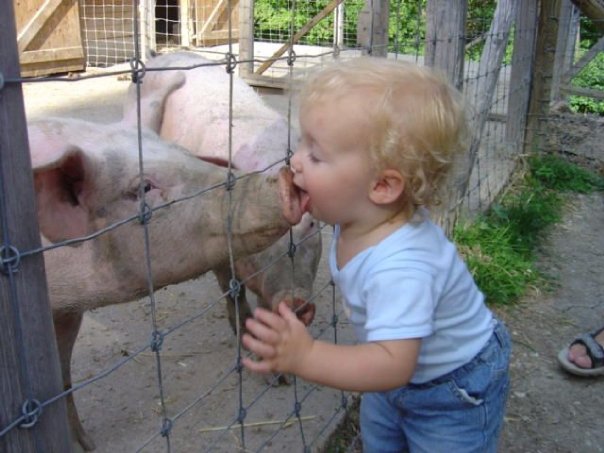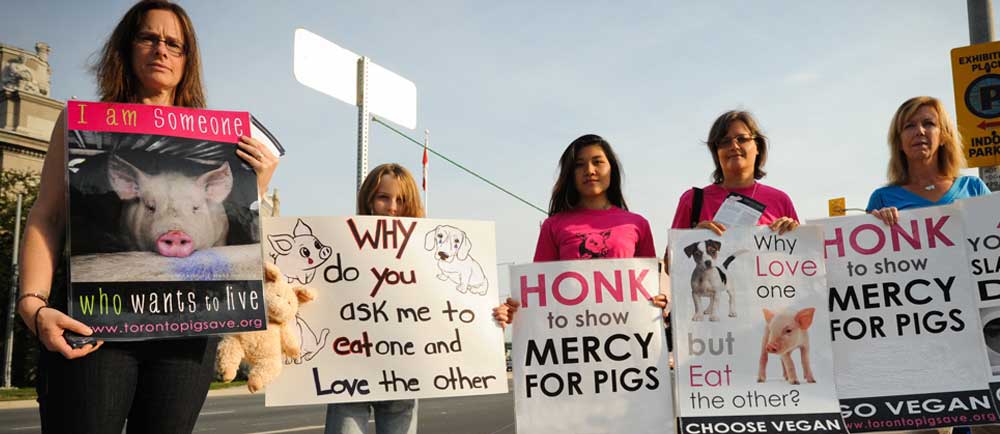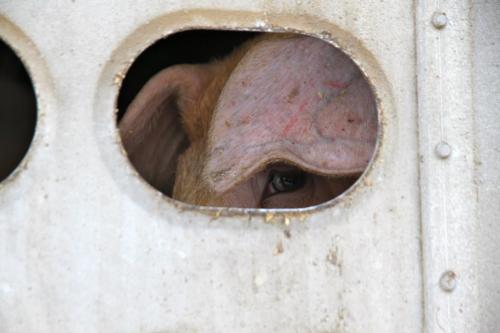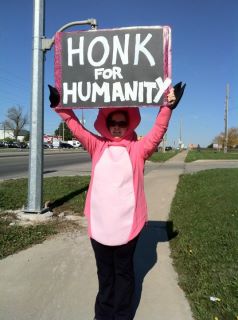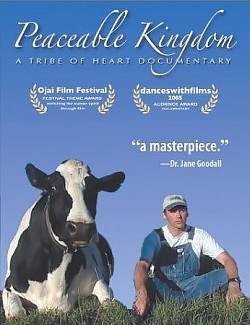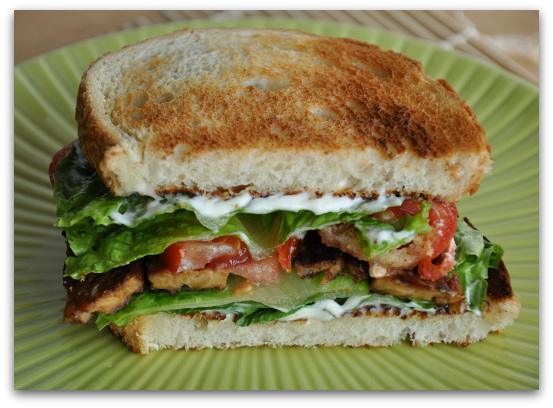Here You Have a Home: 10 Questions for Richard Hoyle Founder of The Pig Preserve
Hey Guys,
I am certain you will enjoy the following.
It’s an interview with, as you will soon see, this wonderful guy and true animal rights hero, Richard Hoyle of The Pig Preserve.
I first learned about The Pig Preserve after Anita Krajnc, head of Toronto Pig Save, visited them and started posting jaw dropping pictures of pigs at the preserve on her facebook. I didn’t know exactly why she went, but I imagined she probably needed to see happy pigs after seeing pigs in the trucks so much.
I started following The Pig Preserve on facebook. Best page on facebook. I looked through all of their photos on facebook last night. It was like reading the most beautifully photographed idyllic book. Photos from life on the farm, but a happy farm, where all the pigs are loved and respected. The photos have captions and stories about life at the Preserve.
Oh yeah, The Pig Preserve is a sanctuary for rescued pigs where the pigs have “completely free and natural access” to 100 acres of woods, pastures, and ponds. They are basically allowed not just life and liberty, but the pursuit of happiness as well.

(another 100 Aker Wood)
I am so happy to be able to show you where that voice in the facebook photo captions is coming from. In this interview, you can see that it comes from the soul of the founder of the Pig Preserve himself.
Also if you enjoyed these photos and the spirit of this guy, give a $ or $$. You will see after reading the interview, this is as worthy a cause as it gets. I myself felt inspired to support this cause just now.
Oh yeah, and if you are like me, and like to go even more in depth, watch this 2 part video on youtube of Richard and the Pig Preserve. And meet the man himself.
(the following photos are all from the facebook page of The Pig Preserve (many taken by Anita Krajnc of Toronto Pig Save)
And Now.
10 Questions for Richard Hoyle Founder of The Pig Preserve
1. Could you say a little about yourself and The Pig Preserve in your own words, whatever comes to mind, to get us started.
Richard Hoyle: Let me try to encapsulate my 65 years into just a couple of sentences. After a misspent youth in high school, I was “encouraged” to join the Marine Corps. During my career I attended both The Citadel and the University of South Carolina, served a tour in Vietnam as a Lieutenant, obtained a master’s degree in management from the Naval Postgraduate School in Monterey and eventually retired as a Major.
During my last few years in the Marine Corps I had become active in several local volunteer fire departments. So my second career was as a firefighter and paramedic with the Fairfax County, VA Fire and Rescue Department. I also continued my service with the volunteer fire and rescue department where I lived, eventually serving as the Fire Chief. I retired from Fairfax Fire Department in 2005.

In 1985 two small herds of miniature Vietnamese Potbellied pigs were imported into the country from Europe. The original plan was for these pigs to be bred to provide miniature pigs to zoos. But, in an unforeseen twist, these pigs rapidly became extremely popular as the fad pet of the late 1980’s and early 1990’s. My wife, who had always been a “pig lover” began a crusade to get one as a pet. Finally, in order to bring some semblance of peace and quiet into my life, I agreed to buy her a potbellied pig…a decision that would prove to be a major factor in changing my life forever.
I wish I could say that there was some magical, bonding moment when we saw our first potbellied piglet. But, truth be known, the little piglet we went home with from the breeders was the first little piglet that the breeder could catch as a dozen or more little black shapes darted back and forth in their pen squealing at the top of their lungs.
Being of Irish blood, I named the pig Paddy Murphy…after the old Irish saying: “To be as Irish as Paddy Murphy’s pig”.
It took about two hours to realize that dealing with a piglet was nothing like dealing with a puppy or a kitten. It also became glaringly obvious that we knew absolutely nothing about pigs…especially how to keep a pig as a house pet. I am convinced that Paddy Murphy survived in spite of us rather than because of us…for we certainly made just about every mistake a pet pig parent can make. But Paddy Murphy was very patient as she worked to train us. Her desire to be outdoors was obvious, so I cut a “pet door” in the back door and Paddy Murphy became an “indoor/outdoor” pig…coming and going as she wished between the house and the large fenced back yard.
After a few months we decided that Paddy Murphy needed a companion pig. As fate would have it, one of my firefighters had discovered a young miniature pig running in his yard and had caught it with a fishing net. And so Damien Gilhooley (aka: Damien the Demon) came to live with us.


Soon the phone was ringing regularly with people asking us to take in miniature pigs. To this day I’m not sure how the word got out about us. But within a year or so we had something like 22 rescued pigs on our tiny acre and a half plot of land.

At this point I told my wife that we either had to quit taking in pigs or learn how to do pig rescue properly. We discovered a pig sanctuary in West VA…possibly the first true pig sanctuary in the US. We contacted them and started what would end up being about a two year internship with them as we learned as much as we could about pigs and how to operate a sanctuary. In the meantime we were searching for a bigger plot of land and finally settled on a 17-acre piece of land in Culpeper, VA.
We called our sanctuary Minipigs, Inc. At that time we took in only miniature pigs and, at one time, had over 200 rescued pigs living at the sanctuary. In the mid 1990’s one of our board members asked us to take in a young Yorkshire farm pig she had rescued. Babe had been born with a malformed and stiff rear leg and had been thrown in a ditch to die when our board member found her, brought her home and raised her. It wasn’t long before my wife and I were smitten with the “gentle giants” and realized that these marvelous creatures had precious few options if they managed to somehow escape slaughter by the tender age of 6 to 8 months. It also didn’t take us long to realize that 17 acres was woefully inadequate for a sanctuary that was rescuing farm pigs as well as the feisty miniature pigs.

Since my retirement from the fire department was fast approaching, we began a search for a larger piece of land on which to build a different kind of sanctuary…a Pig Preserve. In late 2005 we found the perfect place in Jamestown, TN and in early 2006 we began relocating pigs and all of our farm equipment to the new sanctuary. Minipigs, Inc. was dissolved and, in its place, The Pig Preserve was formed.
2. I read somewhere that you said your wife had always been interested in pigs, and you guys first got a potbellied pig as a pet. Do you know what drew your wife to pigs her whole life? And what did you think of the idea at first?
Yes…Laura has always been a pig lover. Our home had always been a repository for all kinds of “pig knick knacks”. I’m really not sure what caused her to fall in love with pigs at an early age…but I have since met hundreds, maybe thousands, of people who feel just as she did. I never thought much about it until it actually became possible to buy and own your very own miniature house pig. But, being a woman of singular purpose and fully capable of putting me under severe duress until she gets what she wants, I quickly realized that my life was going to be a living hell until Laura got a pig. My conversion to pig lover was probably the strangest and most bizarre event in my life. Something about Paddy Murphy and her partner, Damien, just got to me. Suddenly the thought of eating ham and pork products became abhorrent to both of us. And, within a short time, we were both vegetarians. The transition from owning a couple of pigs to running a sanctuary just seemed like a natural progression for us. I don’t recall us ever arguing about whether or not to start a sanctuary…it is just something that both of us felt we had to do. Did either of us realize that the pigs and the sanctuary would grow to consume or entire lives, all our money and every minute of our time? No…I don’t think so. But I know that neither of us have ever had a moment’s regret. The only regret we have today is that we can only rescue such a precious few and we keep striving to find ways to do more for a greater number of pigs.
3. What was having a pig as a pet like in the beginning? Were you surprised by what pigs are like? What was she like?
As I mentioned earlier, neither of us had any idea of what we were getting ourselves into when we brought Paddy Murphy home as a week piglet. But we did sort of sit back and evaluate how pigs were different from dogs and cats and, with that, came the realization that we would have to totally rethink a lot of aspects of our lives and cast out a lot of old notions we had about animals in general.

We never realized, before we got Paddy Murphy, how intelligent and clean pigs were. We also never realized the depth of their personalities or the sometimes cunning ways they have of figuring out problems and getting what they want. Pigs are probably the most hedonistic of animals and will go to great lengths to get what they want. And, because they have a limited ability to reason and problem solve, they can be a real challenge to keep up with at times. It has been said that pigs have the intellectual capacity and the maturity of a 4 year old human child. I would dispute that. I think that they are more like a 5-6 year old child and, when working with the pigs, I often feel like I am running an out of control nursery school for four legged kids.

Paddy Murphy was cunning. She figured out how to operate the gate on the chain link fence that separated the yard from the pasture. She did this by watching me open the gate with my hands, figured out how the gate latch worked and then figured out how to use her snout, her shoulder and leverage to make the gate pop open when my back was turned so she could get out and graze on her own.
Paddy Murphy went on to live over 20 years and we were devastated when she finally died of cancer. But she was the “grand old dame” of the sanctuary for many years and watched with an amused detachment as each new pig arrived at the sanctuary.

4. I read that all of a sudden people started sending abandoned pigs your way. Did you suddenly realize that you wanted to make a sanctuary or did it kind of fall in your lap? Were you guys excited to start a sanctuary–was it a huge change in you life for you?
The sanctuary just sort of evolved naturally as our love for pigs grew, the need for sanctuary for these unique animals became apparent and as we felt more comfortable with our ability to care for an increasing number of pigs. Doing the internship with the pig sanctuary in West VA was a good way to learn a lot before we took responsibility for a large number of pigs ourselves. And, in truth, we learned a lot about how we didn’t want our sanctuary to operate as well. A sanctuary is a reflection of the owners…a lot of your personality and beliefs go into your sanctuary. And no two sanctuaries are alike. For us just rescuing and saving the pig was not enough. We wanted to afford them as good and natural a quality of life as we possibly could. This idea became the germ of the idea that eventually became The Pig Preserve. For us just saving the pig from death, putting it in a pen with a bunch of other pigs, feeding and caring for the pig until it died was simply not enough. The more we learned about the pigs and the more we came to understand and respect them the more we felt that a sanctuary should provide more than just rudimentary food, shelter and vet care.


In the “early days” it was almost impossible to find competent veterinary care for pigs. Few vets knew much about pigs other than what it took to raise them quickly and cheaply for slaughter. And they knew virtually nothing about the miniature pig breeds. So for years we were pretty much on our own when it came to veterinary care. Slowly over time we convinced a few foolhardy vets to work with us and now we have a much better network of vets who are at least fairly competent on working with pigs. My training and experience as a paramedic has really helped since there are so many similarities between pigs and humans. For years I would even take medical issues with my pigs to the doctors in the ER’s I used to take patients to at work. I would pick the brains of the human doctors and then go back and apply their advice to the pigs.
It is still sometimes difficult because a sanctuary is truly a 365 day a year operation. You basically have no life outside of the sanctuary. The pigs don’t recognize holidays. Nor do they care that you have the flu and don’t feel like getting out of bed in the morning. Your life revolves totally around the pigs, their needs and their schedule. I can honestly say that neither of us has had a vacation in over 20 years. But we knew this level of commitment would be necessary when we started. We went into it with our eyes open. Each day starts early and ends well after dark. At any given time there will always be a couple of pigs you are worried about who are sick or injured. You spend a lot of nights hauling sick pigs to the University of Tennessee School of Veterinary Medicine and a lot of nights sleeping in barns keeping watch over sick and injured pigs. There is some kind of unwritten pig rule that pigs only get sick or injured on major holidays, during driving snowstorms or when your local vet is out of town. But it all comes with the territory.
5. How did you get the brilliant idea to make your sanctuary be a place where pigs can be as free as possible and come and go as they please. Were you nervous the pigs wouldn’t know how to fend for themselves?
The concept of The Pig Preserve probably began as a germ of an idea in my mind several years before it became a reality. I spend a great deal of time simply observing and watching the pigs. They are fascinating creatures…even more so when they are in groups. The more I watched and the more I came to understand these marvelous creatures the more I realized that they are nomadic by nature. Pigs also have a desperate need to be part of a social group. More than any other animal, pigs are happiest when in a group of other pigs. And, when given the opportunity, they love to roam, forage, investigate their world and enjoy the companionship of other pigs.

I saw where people who rescue other animals had used the preserve concept with good results. They were caring for happier, healthier and more social animals. I began to wonder why the same concept could not apply to pigs. The “experts” all told me that farm pigs could not live like that…that they had been genetically engineered to the extent that they were no longer really pigs. They told me that various breeds of pigs could not live together…especially the miniature pigs and the farm pigs.
When I told people about my preserve concept many “pig people” accused me of wanting to create a situation that would allow only for the survival of the fittest pigs. I believed, though, that rather than a survival of the fittest, the preserve would give them the gift of freedom. But transitioning from the traditional sanctuary model where the pigs are pretty much contained and constantly supervised and monitored was a hard one at first…and a bit scary. But I have gotten used to the fact that the pigs will spend the bulk of each day on their own and in the company of other pigs doing what they want to do. I do still make it a point to physically see and touch each and every pig every day to make sure that each pig is sound and healthy. The easiest time for me to do this is every evening at feeding time. That is why feeding takes me between three and four hours each day and why I feed each social group of pigs individually.
I still have to maintain a relationship with each pig here. I need for each pig to be comfortable enough with me so that if the pig becomes ill or injured, they will let me work on them and render care. That is easier with some pigs than with others. Some pigs are much more “people friendly” than others. Plus, we have a long history of taking in “problem pigs”….pigs who were passed through several homes or through several sanctuaries and who were deemed “aggressive” or “hard to handle”. The problem pigs often become my favorite pigs. Not because I enjoy the challenge, but because there is no such thing as a problem pig. When given the proper environment and the proper understanding and respect the “problem pigs” often become my biggest love mooches.
After almost 8 years now, I can honestly say that our pigs are as healthy, safe, happy and secure as any pigs I have ever seen. Our potbellied pigs routinely live to be 20 years old. We were told that farm pigs would seldom live past 10 or 11 years of age. I have a large population of farm pigs who are 16-18 years old and who are still going strong. The preserve concept works. When pigs are provided with an environment that contains sunlight, fresh air, the opportunity for exercise, the ability to socialize with other pigs, the ability to graze, forage, roam, swim and play along with a nutritious diet of all natural grains they are simply healthy, happy and, consequently, long lived.
This is not rocket science. We are simply creating a sanctuary where the needs of the pigs are paramount. We tailor our operation of the sanctuary to the pigs’ needs rather than what is the easiest or most convenient for us.


The “downside” to the preserve concept is mostly in the worries that it brings to me as their caretaker. We worry about the coyotes and bears that frequent the property. We worry about the pigs getting bitten by a venomous snake. We worry that someone will try and sneak in and shoot one or more of the pigs for meat. But we keep a number of rescued dogs and cats here at the sanctuary as well. The dogs are a great coyote deterrent and the cats help keep the snake population at bay. Actually, the pigs are pretty adept at killing snakes themselves. And I spend a great deal of time roaming the sanctuary and the woods making sure that fences are still intact and that nobody is getting any ideas about sneaking onto the property to try and hunt any of the pigs. The fact that we are so remote and surrounded by hundreds of acres of deep woods helps a great deal.
6. What are pigs like? Have you found they all have vastly different personalities or are there certain traits that go along with the species of pig.
We have basically three kinds of pigs here. The miniature pigs…including the common potbellied pigs, Kune Kune pigs, Captain Cook miniatures and a few European blue butts (sometimes called Royal Dandies). Quite a few of the miniatures are crosses of one or more types of miniature pigs. A few are even crossed with feral pig and/or farm pig. Farm pigs…including Yorkshires, Berkshires, Hampshires, Old Spots, Oxford Brown and Spots, Red Wattles and Middle Whites…as well as a few crosses of these breeds. They range in size from youngsters at 40-80 pounds to 1200 pounds or so for some of my larger, mature farm pigs. Finally, we have a few feral pigs. Most of the ferals originated from Florida where they were found as babies and hand raised until they got too large and too rambunctious for their owners.
The miniature pigs are my most argumentative pigs. These little pigs love to argue and fight both with one another and with any other pig they think they can pick a fight with. They are headstrong and willful little creatures and are always into some devilment. If there is every a disturbance in one of the barns I can bet money that it was a miniature pig that started it. The frequently band together to form roving bands of thugs…always looking to see what they can get into. It is hard, though, not to love pigs with that much spunk and spirit.
The farm pigs are truly the “gentle giants”. They are much more laid back and easy going than the miniature pigs. They are also extremely affectionate pigs. Lucky for the miniature pigs that they are so easy going as the miniature pigs love to pick fights with the much larger farm pigs. The farm pigs usually just turn and walk away. But, if they do get fed up with a particularly aggravating and tenacious little pig, they will just take their massive heads and flip the offending miniature pig head over heels. In winter time the miniatures love to bury themselves in the hay up under the massive farm pigs for the heat that they give off. To their credit, the farm pigs are very careful around the miniature pigs and go out of their way not to step on them or injure them in any way.
The ferals are just a joy. They are the most active of all the pigs here. They love to run, jump and play and have an inexhaustible energy. Even in winter they will be out playing in the snow. They can be problematic to work on when they get sick or injured because they do not like to be confined in any way. They love to play and I have to be careful when I play with them as they sport some impressive and razor sharp tusks.
But within each breed of pig there are as many different personalities as there are pigs. Some are more vocal than others. Some are more naturally active than others. And each has his or her own quirks, likes and dislikes. Getting to know each pig and his or her personality is both challenging and fun. And I never tire of spending time with them.
7. In the media you always hear about how smart pigs are, and even how loving and sensitive pigs are. Do you have any examples you could share about that from your preserve. When I watched Toronto Pig Save’s videos for the first time and looked into the eyes of the pigs in the truck, in an instant I saw how intelligent, understanding, and emotional pigs were. I felt like their eye was like a human eye magnified 100 times so that the emotion was even more clear. I think pigs are amazing and am so curious as to what they are like in person. I also wonder, do the pigs ever seem like they understand you have given them their freedom and appreciate you for that?
You can see a pig’s soul in its eyes. They are not only intelligent creatures but they carry with them a great range of emotions. I have watched with awe the grieving process when one of the pigs in a particular social group dies. Each pig in the group comes up to pay their respects. They cry and grunt as they prod the dead pig with their snouts. And the alpha pigs in the group will not let me approach to move the body until the group has finished saying their goodbyes. It is something that I have grown to respect. The group will not be the same for several days and, often, the closest companions of the dead pig will go off by themselves for several days without eating. I believe they are simply grieving.

A sick pig is never alone. There will always be one or two of their social group with the sick pig. They rotate from pig to pig, but a sick or dying pig is always in the company of one or more of their group. And if I approach the pig to give it a shot or try and bring food or water to the sick pig, I have to be very careful around the “sentries” as they are very protective of their sick herd mate.

Pigs do not respond well to corporal punishment or correction. Usually, all I have to do is raise my voice and, occasionally, give the offending pig a shove on the flanks to correct their behavior. It is important that I correct them in the same way a more dominant pig in their group would elicit compliance. Pigs understand this. And I must maintain myself as the “alpha” pig in the group or working with the pigs would become chaotic and dangerous. Once in a while a pig (almost always a miniature pig) will challenge me. It is important that I not back down and once in a while a shoving match will ensue. Eventually, the challenging pig will retreat, although not without a great deal of grumbling and grumping.
I occasionally get bitten and more frequently get “tusked” by a male pig. But never have these injuries been inflicted intentionally by a pig. They are not aggressive creatures by nature. I do have to be very aware, when working around the pigs, that these are very large animals with a very poor understanding of how big and long they actually are. It is very easy to be injured when several pigs get a bit rambunctious around me or when I am trying to coax a sick or injured pig into a stall or trailer. Bumps, bruises, pratfalls and the occasional tusk slash are all part of dealing with animals this large.

8. Do you enjoy running the sanctuary. For an animal lover, it seems like a lot of fun…though I’m certain it must be extremely hard work. Did you ever imagine your life would be devoted to caring for pigs. (I think it is awesome). Also do you have any advice for someone who wants to start a sanctuary of their own?
I do enjoy running the sanctuary…for the most part. On any given day I will be a farmer, a veterinarian, an electrician, a plumber, a carpenter, a fence repairer, a tractor mechanic or a pig psychiatrist. Occasionally with volunteers and interns I am even a teacher. I never tire of spending time with the pigs and have been known to simply lay down in the barn and take a nap among a group of pigs….or sit under a tree for an hour or so with a couple of big farm pigs. There are days in the heat of summer or the middle of a blinding snow storm when I am out dealing with a bunch of pigs who blame me for the bad weather when I wonder why I ever took on a job like this. Pigs, by and large, are not big on showing gratitude.

Most of the work running a sanctuary is blue collar, manual, dirty, mundane labor. Much of it is mind numbingly repetitious work. The pigs always like to help with projects. So, no matter what I am doing, I can always count on a dozen or so pigs of varying sizes stopping by to offer their assistance by stealing tools, knocking over ladders, tearing open bags of cement, upsetting buckets of nails and staples and scratching their backs on some posts that I spent an hour getting in the ground straight and plumb. I can always count on a two hour job taking three or four hours thanks to the “help” I always get from the pigs. But…I cannot stay angry with them. It is their nature to be inquisitive and they find what I do fascinating.
And there are days of sadness when I have to put down a pig I have raised from a piglet and whom I have cared for for 16 or 18 years. I always ask the vet to let me give the pig the shot that will sedate him or her for the euthanasia. I feel it is my responsibility as the pig’s caretaker. And I bury each and every pig who dies here with sadness and reverence…and I say my goodbyes in private over the pig’s grave. But I have learned to accept that every pig who comes here will die here. And I never know how long each pig has here before it is his or her time to go. So…I have adopted the philosophy that I will treat each pig here as if it is his or her last day on earth.
Probably the only constant and nagging fear that I live with is the eternal question of how I am going to continue to generate the funds and donations it takes to keep the sanctuary alive and functioning. Funding is the only aspect of running a sanctuary that gives me sleepless nights and constant, nagging worry. I am not a good fundraiser. And nothing in my education or work experiences has given me the skills to raise funds or bring in donors.
A sanctuary is a labor of love that must be run like a business. Unfortunately, my heart often gets in the way of my brain when it comes to accepting a new pig. I am terrible about saying to myself: “Well, you can fit in just one more pig”. This is especially hard when it comes to the farm pigs and ferals as they have precious few options. They are too large to be adopted and so few sanctuaries are willing or able to take in the gentle giants. And often, if I refuse to take in a pig, I know that my refusal is going to result in the pig being put down or sold for slaughter. It is, by far, the toughest of any of the decisions that I have to make as a sanctuary director.

When we set the sanctuary up we set it up so that donor funds would only be used for the direct care of the pigs. That means that donor funds are used only for feed, veterinary care, fencing and barns. My wife and I pay the sanctuary mortgage, the taxes and the insurance. We also provide all of the farm equipment necessary to run the sanctuary and we pay for all of the maintenance and repairs to equipment. We also absorb all of the administrative costs of running the sanctuary.
The sanctuary’s basic feed bill (in summer) is $2200 a month for approximately 100 pigs. In winter this will jump to $3000 a month. This does not include the money I spend each month for apples (a bushel a day) or the cost of special feed for the elderly or special needs pigs (rice, oatmeal, etc….). Vet bills can run from $100 a month to several thousands of dollars…and there is no way to predict from month to month what it will be. Several elderly pigs are on daily medications for pain, arthritis, etc….. A new barn or run in shed for the pigs will run anywhere from $3000 to over $4000 dollars. In winter we go through dozens of bales of hay each week to provide fresh bedding in all of the 12 barns.

Each pig I agree to take in will increase the sanctuary’s bills by hundreds of dollars a year. The simple mathematical equation is that I can take in no more pigs than I can reasonably expect to be able to provide for. If I ignore this equation, the sanctuary will soon be bankrupt. And then what happens to the 100+ pigs living here? Most cannot be re-homed and there are no sanctuaries who could take in this many pigs…especially the farm pigs. Many of my pigs here now came from smaller sanctuaries that “went under” a few years ago during the recession.

As for advice for people who would like to start a sanctuary….. This way of life requires a particularly unique form of mental illness. Not many people are afflicted with it. When I first started my internship with the pig sanctuary in West VA the director asked me why I wanted to operate a pig sanctuary. I replied that it was because I loved the pigs. He told me: “Loving the pigs is not enough”. It took me several years to appreciate what he was trying to tell me.
Most of my fellow sanctuary owners are elderly…my age or older. There seems to be a dearth of young people who want to take on this type of lifestyle. I’m not sure what is going to happen as we get older and either become to crippled up to do this any more or drop dead in the pasture. It is something for which I do not have a good answer. We have worked with a number of “interns” over the years in hopes of finding someone who would be willing to step into our shoes when we can no longer care for the animals. Several of them have gone on to become vets. Most (the younger ones) discovered alcohol and girls (or boys) and drifted off to enjoy a “real life”. But I cannot use this dilemma as an excuse not to rescue and care for those precious few we can afford to save. As with trying to make the monthly feed and vet bills….I have to have faith that somehow things will work out as they are supposed to and that God will provide what is needed to keep the sanctuary going.
9. In Jenny Brown’s book The Lucky Ones, she said sometimes when she goes to sleep at night with her husband she imagines a little dome of love and happiness surrounding her, her husband and the sanctuary. I thought that was so beautiful. I imagine you must feel so content and happy knowing you have created such a wonderful home for so many pigs. Do you feel like there is a peace of mind that comes with your job?
Mostly at night I just feel dog tired and ready to lay my aching body down for a few hours…assuming I don’t have to get up several times to check on a sick pig. But, yes, there is a sense of fulfillment in doing what I do. Sometimes I have to stop and search for it because I get so caught up in the day-to-day chores and headaches of running the sanctuary. But when I go out at night and stick my head in one of the big barns to check on the pigs and hear nothing but contented snoring and the occasional grumble as two pigs discuss sleeping arrangements I feel very contented that what I am doing actually means something. When I look out over the pasture and I see a couple of dozen pigs peacefully grazing surrounded by several deer and a flock of wild turkeys I feel very lucky to have been able to do what I do. I enjoy my time with the animals and have come to prefer their company to the company of most humans I know. There is a peace and serenity here that comes from knowing that every animal out in the field would be dead were it not for the sanctuary. I feel that serenity again every time I watch a pig step out of the trailer for the first time and see sunlight, green grass and blue skies. And I get to enjoy watching that pig take their first tentative steps of freedom. That’s a joy that no amount of money can buy.
I know that we are able to save a pitifully small number of pigs in the grand scheme of things. Not even a drop in the proverbial bucket. But God has spared these special few for a reason…and I think that it is because he wants them to be ambassadors for their species. The stories behind each pig who arrives here border on the miraculous. And I am very glad to be able to be a small part of that miracle.
I can’t dwell on that subject for long. It is too depressing. For years I was a meat eater…a meat lover. I am not an evangelist. I know that many people who have visited the sanctuary have been touched by the pigs and have gone on to either quit eating pork or have become vegetarians or vegans themselves. And I am glad that my sanctuary was able to provide them with that motivation and that understanding of the horror and abuses that occur in the meat industry every day. I think that more and more people are becoming aware of the horrors of the factory farms. Many of them are slowly coming around to the understanding that a plant based diet is healthier for them and for the planet. I have to believe that one day…long after I am gone…that there will be no more meat eaters and there will be no need for sanctuaries like mine. I’d like to think that in my own way I am an animal rights activist. But my activism is a bit different from most folks. I rescue and care for with love and respect those precious few I can and say prayers for the millions upon millions that I cannot help.
11. One final question. How does The Pig Preserve make money and how can we help?
Our funding comes from private donations. [editor is including this link to support The Pig Preserve or this one for those not on facebook] We do not have an advertising budget. We rely on word of mouth and on social networking like Facebook to get the word out about the sanctuary. We get donations each month ranging from $5 to several supporters who graciously give us $200 a month. Once in a while we get a small grant (usually $500 or less). Some of our pigs are “sponsored” by people who were instrumental in rescuing the pig and getting him or her to the sanctuary.
Often we take in pigs from people who agree to provide money each month for their pig’s room and board. In about 50% of the cases the money lasts for only a few months and then disappears. Obviously, these people know that we are not going to abandon their pig just because they did not send the promised amount each month. As they say: A gentleman’s agreement presupposes that both parties are indeed gentlemen and will be true to their word”.
Many of our long time supporters are working folks who don’t have a lot of money to spare. They simply like what we do and feel that they would like to contribute to keeping the sanctuary alive and well. Every once in a while we run across some gems like Joanne O’Keefe and Anita Krajnc who visited with us for a few days and want to help us get the word out about the sanctuary. Anita has provided thousands of photographs of the sanctuary and the pigs. Joanne is helping me with Facebook and is working or brochures for us and updating and redesigning our website. They took pity on my poor computer skills and have really been a Godsend to us.
We have a small board of directors. But all on the board have full time jobs and do animal rescue themselves…so they are stretched way too thin to do much more than they are already doing.

The more the word gets out about the sanctuary and what The Pig Preserve is doing, the more supporters we will get. I appreciate you giving me the opportunity to rave on about the sanctuary and the pigs. Thank you.
Any of your readers are more than welcome to contact me personally if there is more information I can provide. I am always available by cell phone at 540-272-3958 and I check my email twice a day thepigpreserve@gmail.com Of course they can also find us on Facebooks.
OK guys. Back to me. How amazing was that. Beautiful, funny, profound and bittersweet. (I’m not a good fundraiser either, but if you feel so inclined, you know what good things it will be supporting.)
Question for you: Did you have a favorite part or photo of the interview? If so, would you share in the comments below?
Mine was that image of Richard checking in on the pigs at night in the barn and hearing the pigs snoring and grumbling, or that photo of him in a fireman’s jacket in the snow with a pig, or the story about how the pigs pay their respects to their loved ones when they die. What is yours? I would love to know.

